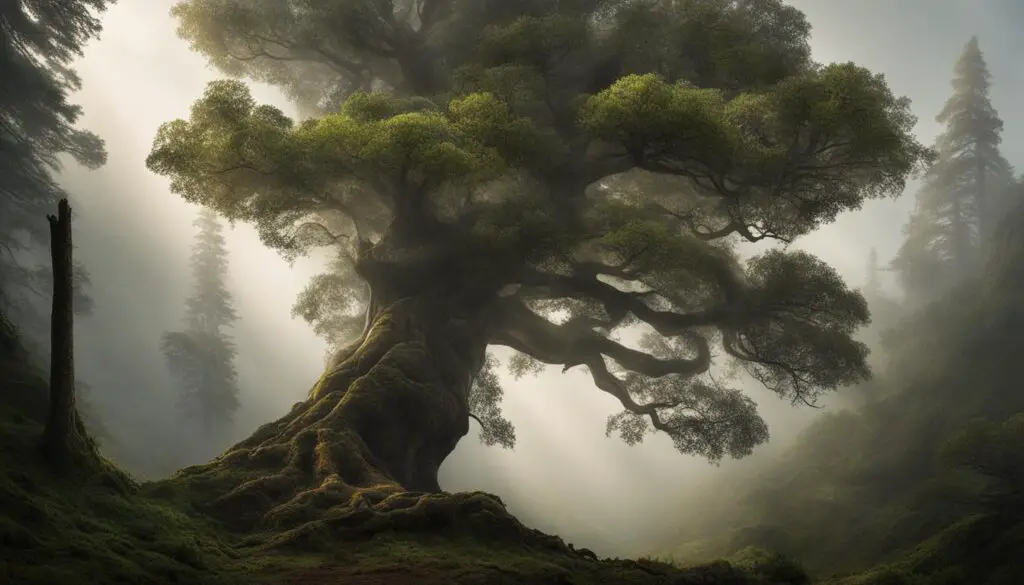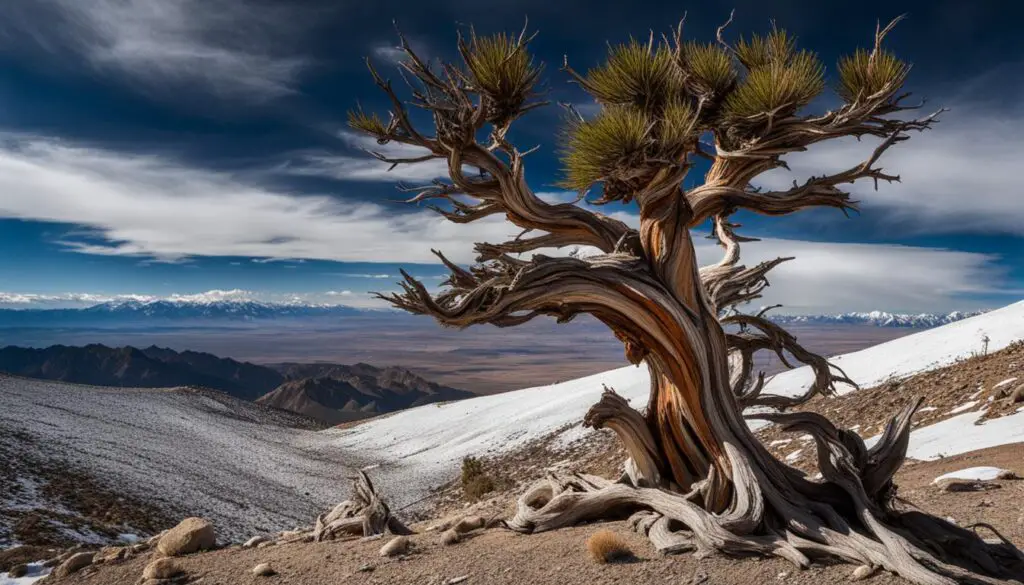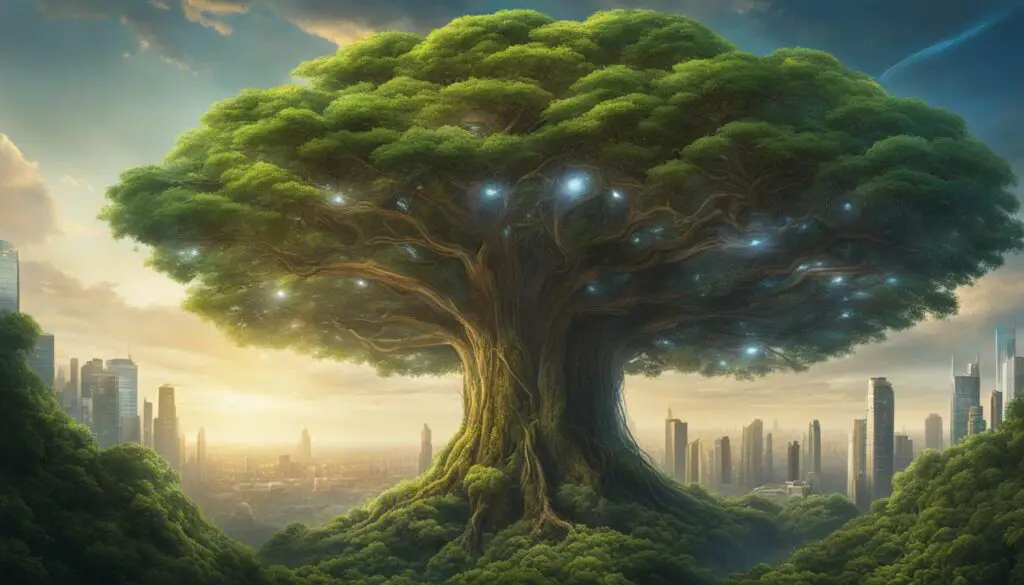Trees have been silent witnesses to the passage of time for centuries, and the study of tree rings, or dendrochronology, allows us to unlock valuable insights into their lives. Tree rings represent a year of growth and can reveal a tree’s age, response to climate variations, and past ecological events. Certain tree species, such as the Great Basin Bristlecone Pine, can live for thousands of years. Tree rings also provide information on growth rate, climate and environmental records, and have even been used in archaeology.
Key Takeaways:
- Tree rings are like records of a tree’s age, growth, and response to climate variations.
- Some tree species, like the Great Basin Bristlecone Pine, can live for thousands of years.
- Tree rings provide valuable information on growth rate, climate records, and even archaeological dating.
- The width of tree rings reflects growth patterns and can indicate favorable conditions or periods of stress.
- By studying tree rings, scientists can reconstruct past climates and understand the impact of climate change on ecosystems.
What Are Tree Rings?
Tree rings, also known as growth rings, are visible as concentric circles when a tree trunk is cross-sectioned. Each ring represents a year of the tree’s life and serves as a record of its growth and the conditions it experienced. Dendrochronologists, scientists who study tree rings, analyze these rings to determine a tree’s age, growth patterns, and response to climate variations.
“Tree rings represent nature’s diary.”
Lighter colored rings indicate wood growth in spring and early summer, while darker rings indicate growth in late summer and autumn. The width of each ring reflects the tree’s annual growth rate, with wider rings indicating favorable conditions and abundant resources, such as water and nutrients. Conversely, narrower rings indicate periods of stress or limited resources, such as drought or nutrient deficiencies. Seedlings typically grow faster than mature trees, resulting in progressively smaller growth rings as the tree ages.
In summary, tree rings are a fascinating natural phenomenon that provides a record of a tree’s growth and the various environmental factors that influenced its development. These rings offer valuable insights into the past and play a crucial role in understanding the history and ecology of our planet.
The Longevity of Trees
Some tree species have the incredible ability to live for hundreds or even thousands of years, making them some of the oldest living organisms on Earth. One remarkable example is the Great Basin Bristlecone Pine, which can exceed 4,000 years in age. Determining the age of these ancient trees is often done by counting the tree rings, but scientists have developed a technique using thin sample cores to avoid cutting down the entire tree.
The Great Basin Bristlecone Pine’s longevity is a testament to its remarkable adaptability and resilience in challenging environments. These trees have survived countless climate variations and ecological events throughout their millennia-long lives. The study of their age provides valuable insights into the past and serves as a window into the history of our planet.

Understanding the longevity of trees not only fascinates us but also offers important lessons for the future. The ability of these trees to adapt and flourish for such vast periods of time underscores the importance of conservation and the need to protect our natural environments. The oldest living organisms on Earth remind us of the fragile interconnectedness of our ecosystems and the profound impact that climate change and human activities can have on our planet’s biodiversity.
Growth Rings and Climate Variations
Growth rings in trees provide valuable insights into their growth patterns and their responses to the surrounding environment. Each ring represents a year of growth and offers a glimpse into the tree’s annual growth rate. Wider rings indicate favorable conditions with abundant resources, while narrower rings suggest periods of stress or limited resources such as drought.
By analyzing growth patterns across different trees and regions, scientists can identify climatic variations that occurred over long periods of time. These variations may include droughts, floods, or temperature fluctuations, providing a historical record of climatic conditions.
The width of growth rings can be influenced by a variety of factors, including temperature, precipitation, and soil conditions. In regions with a distinct wet and dry season, the growth rings may display alternating patterns of wider and narrower rings, reflecting the annual climatic variations. These growth rings act as natural archives, storing information about past climatic events.
Understanding Climatic Variations
Tree rings play a crucial role in understanding climatic variations and their impact on ecosystems. By studying growth patterns in trees, scientists can reconstruct past climate conditions, identify trends, and predict future changes. This information is essential for developing strategies to mitigate the effects of climate change.
- Tree rings provide a long-term perspective on climate variability, extending far beyond the limits of human records.
- Comparing growth patterns between different tree species can reveal regional and global climatic trends.
- Tree rings can help identify periods of extreme climate events, such as prolonged droughts or unusually wet seasons.
Growth rings offer a unique window into the past, enabling us to better understand the complex relationship between climate variations and the health of our ecosystems. By studying these natural records, scientists and conservationists can make informed decisions to protect and preserve our environment for future generations.
Reliability of Tree Ring Growth
When it comes to reliable tree ring growth, the Quercus genus, which includes Oak trees, takes the spotlight. Oak trees are known for their well-defined annual growth rings, making them excellent subjects for dendrochronology. Unlike some other tree species, Oak trees rarely miss an annual ring development. This reliability can be attributed to their slow growth rate, dense wood structure, and long lifespan.
The Oak tree ring growth provides valuable insights into past climate patterns and environmental changes, making them important tools in understanding the ecological history of our planet. By analyzing the growth patterns of Oak tree rings, researchers can uncover information about historical events, such as floods, droughts, and temperature variations. These growth rings offer a unique perspective on our planet’s past and provide a glimpse into the legacies of our natural heritage.
With their well-defined rings and reliable growth, Oak trees offer a wealth of data for dendrochronologists to unlock. By studying the annual rings of Oak trees, scientists can reconstruct the past, piece together historical chronologies, and gain a deeper understanding of ancient societies. The study of Oak tree rings continues to contribute to our knowledge of the world and sheds light on the intricate interactions between trees and their environment.
As we delve into the intricate world of tree rings, we uncover the hidden narratives within. Tree rings are not just records of growth; they hold the key to understanding past climates, environmental patterns, and the triumphs and challenges of trees throughout history. The reliable growth of Oak tree rings opens a window into the ecological history of our planet, providing us with vital insights into the natural world.

The Importance of Oak Tree Ring Growth
- Reliable and well-defined annual growth rings of Oak trees
- Insights into past climate patterns and historical events
- Understanding of ancient societies and cultural artifacts
- Contributing to the ecological history of our planet
Tree Rings and Climate Change
Tree rings hold a wealth of information that allows us to reconstruct past climates and understand the environmental changes our planet has undergone. By analyzing the width, density, and chemical composition of tree rings, scientists can paint a detailed picture of historical climate patterns. These records, known as historical climate records, provide important baselines for assessing the magnitude and pace of contemporary climate change.
Tree rings act as time capsules, preserving evidence of past climatic conditions and natural fluctuations. By examining the patterns and variations in tree ring growth, researchers can detect changes in temperature, precipitation, and other environmental factors that occurred long before human records existed. In combination with other climate proxies, such as ice cores and sediment layers, tree rings offer a comprehensive understanding of our planet’s climatic history.
Furthermore, tree rings contribute to our understanding of how the environment has responded to past climate changes. The growth patterns of tree rings reveal the resilience or vulnerability of tree species to different climatic conditions. By studying how trees have fared in the past, we can gain insights into how they might respond to the ongoing climate change and its associated challenges.
The Significance of Tree Rings in Climate Science
Tree rings are invaluable tools in climate science and provide scientists with a way to reconstruct past climates with great precision. They offer a unique perspective on the long-term dynamics of the Earth’s climate system and help us understand the natural variability that exists within our environment. With this knowledge, we can better predict future climate trends and develop strategies to mitigate the impacts of climate change.
Using Tree Rings to Monitor Contemporary Climate Change
As our climate continues to change rapidly, tree rings remain an essential resource for monitoring and understanding contemporary climate change. By comparing current tree ring growth patterns to historical records, scientists can identify shifts in climate regimes and detect unusual or extreme events. This information is crucial for policymakers, conservationists, and researchers working to address the impacts of climate change and develop sustainable solutions for the future.
Tree Rings in Archaeology
The study of tree rings, or dendrochronology, has proven to be an invaluable tool in the field of archaeology. By analyzing the growth patterns and characteristics of tree rings, researchers can accurately date artifacts and establish chronologies for ancient societies. This cross-referencing technique involves comparing the growth patterns of trees found in historical structures or preserved wooden objects with living trees of known age. By doing so, approximate dates can be assigned to cultural and historical artifacts, providing valuable insights into the timelines of human achievements.
Tree rings play a crucial role in understanding ancient societies by providing unique perspectives on their history. They serve as records of past climatic conditions, capturing the triumphs and challenges faced by these civilizations. By unraveling the hidden narratives within tree rings, archaeologists gain a deeper understanding of how ancient societies interacted with their environment, adapted to changes, and built their legacies.
“Tree rings are like books that tell the stories of the past. They reveal the age of artifacts and enable us to piece together the puzzle of ancient civilizations,” explains Dr. Anna Rodriguez, an archaeologist specializing in dendrochronology. “Through the study of tree rings, we gain insights into the lives and activities of our ancestors, shedding light on their customs, trade routes, and even natural disasters they may have experienced.”
Establishing accurate chronologies through tree rings not only enhances our understanding of ancient societies but also contributes to broader historical research. By aligning tree ring data with other archaeological and historical evidence, researchers can uncover connections between different regions and civilizations, revealing patterns of cultural exchange and influencing the narratives of human history.
Bristlecone Pines and Climate Change

The Great Basin Bristlecone Pine, with its unparalleled longevity, stands as a symbol of nature’s endurance. However, these ancient trees are now facing unprecedented challenges due to the impacts of climate change. Rising temperatures and prolonged droughts have weakened the Bristlecone Pines, making them more vulnerable to bark beetle infestations. Once thought to be less of a threat, these beetles have taken advantage of the trees’ weakened state, further endangering their survival.
The Great Basin Bristlecone Pine’s ability to withstand harsh conditions has been compromised by climate change. Drought-stressed trees are more susceptible to bark beetle attacks, which can cause significant damage and ultimately result in the death of these majestic giants. The weakened state of the Bristlecone Pines emphasizes the urgent need for action to address climate change and protect vulnerable ecosystems.
The plight of the Bristlecone Pines serves as a powerful reminder of the far-reaching consequences of climate change. As these ancient trees struggle to survive, their story highlights the importance of preserving our natural heritage and taking proactive measures to mitigate the impacts of climate change. Protecting the Bristlecone Pines is not only crucial for their own survival but also for the preservation of the unique ecosystems they inhabit.
The Decline of Resilient Forests
The impact of climate change on forests is becoming increasingly evident, with resilient forests facing a significant decline. Rising temperatures and changing weather patterns are pushing these once robust ecosystems to their limits, making them less able to recover from disturbances such as droughts or wildfires. This declining resilience has far-reaching implications for biodiversity and the health of our planet.
As temperatures continue to rise, forests are facing increasing vulnerability. The stress of elevated temperatures can weaken trees, making them more susceptible to pests, diseases, and other disturbances. This vulnerability disrupts the delicate balance of forest ecosystems and poses a threat to the numerous species that rely on these habitats for survival.
The decline of resilient forests is a clear indication of the urgent need to address climate change and prioritize conservation efforts. It is crucial to reduce greenhouse gas emissions, protect existing forested areas, and restore degraded ecosystems. By taking proactive measures to mitigate climate change and protect forest habitats, we can preserve the invaluable services provided by forests, such as carbon sequestration, water regulation, and habitat provision.
The future of resilient forests depends on our collective actions. It is essential to recognize the role forests play in maintaining the health of our planet and take steps to ensure their long-term survival. By working together to mitigate climate change and support sustainable forestry practices, we can help reverse the decline of resilient forests and safeguard the biodiversity and ecological balance they sustain.
The Future of Trees and Life on Earth
As the impact of climate change continues to be felt around the world, the future of trees and their role in sustaining life on Earth is of paramount importance. The implications of climate change on tree species are far-reaching, with potentially devastating consequences for biodiversity and the delicate balance of ecosystems. Rising temperatures, fluctuating weather patterns, and increased frequency of extreme events pose significant challenges to the survival of trees and the countless species that depend on them.
The future of trees is closely tied to the overall well-being of our planet. Trees play a crucial role in carbon sequestration, helping to mitigate the effects of climate change by absorbing and storing carbon dioxide. Their loss or decline could intensify global warming and further exacerbate the environmental crisis we currently face. Additionally, trees provide habitat for numerous species, contribute to soil health, and support the water cycle, making them vital components of resilient ecosystems.
The implications for biodiversity
The impact of climate change on trees extends beyond their individual survival; it has ripple effects on biodiversity and the interconnectedness of species. Many organisms rely on trees for food, shelter, and breeding grounds. As trees face the threat of habitat loss or reduced resilience, the delicate balance of ecosystems is disrupted, leading to the potential decline or even extinction of numerous plant and animal species.
Conservation efforts are crucial in securing the future of trees and mitigating the impact of climate change. By protecting and restoring forest habitats, implementing sustainable land management practices, and reducing greenhouse gas emissions, we can help safeguard the health and resilience of ecosystems. International collaborations, research initiatives, and public awareness campaigns also play a vital role in raising awareness and mobilizing action to address the challenges faced by trees and promote biodiversity conservation.

The future of trees holds profound implications for the well-being of our planet and all its inhabitants. The urgency to act cannot be overstated. From individual conservation efforts to global policy changes, we have the power to make a difference and shape a more sustainable future. The fate of trees is intertwined with our own, and by protecting and preserving these living wonders, we are ultimately safeguarding the future of life on Earth.
The Hidden Narratives Within Tree Rings
Tree rings hold the hidden narratives of our natural heritage, preserving records of triumphs, challenges, and past climatic conditions. As we delve into the intricate world of dendrochronology, we uncover fascinating insights into our planet’s history. Each tree ring serves as a precious record, revealing invaluable glimpses into past climates and the legacies of our natural world.
By carefully examining tree rings, scientists can extract a wealth of information, gaining a deeper understanding of the Earth’s past. These unassuming concentric circles offer a window into the lives of trees and the environments they inhabited. Tree rings act as silent storytellers, chronicling the ebb and flow of seasons, the impact of climate variations, and the intricate dance between trees and their surroundings.
As we decode the hidden stories within tree rings, we gain a greater appreciation for the rich tapestry of our natural heritage. The insights derived from these ancient records allow us to piece together the puzzle of our planet’s past, providing us with a clearer understanding of the intricate interplay between nature and climate. Each tree ring holds within it a piece of the larger narrative, guiding us in our quest to unveil the secrets of the natural world.
Unlocking the hidden narratives within tree rings is a testament to the enduring legacy of our natural heritage. By studying these time capsules embedded in the trunks of trees, we gain a profound appreciation for the resilience and adaptability of our planet’s ecosystems. As we stand on the precipice of a changing climate, these hidden narratives urge us to protect and conserve our natural world, ensuring that future generations can continue to unravel the mysteries concealed within tree rings and safeguard the legacies of our past.
FAQ
How do tree rings provide information about a tree’s life?
Tree rings represent a year of growth and can reveal a tree’s age, response to climate variations, and past ecological events. They serve as a record of a tree’s growth and the conditions it experienced.
What do lighter and darker tree rings indicate?
Lighter colored rings indicate wood growth in spring and early summer, while darker rings indicate growth in late summer and autumn.
How can tree rings be used to determine a tree’s age?
Tree rings can be counted to determine a tree’s age, or thin sample cores can be taken to avoid cutting down the entire tree.
Which tree species can live for thousands of years?
The Great Basin Bristlecone Pine is known to exceed 4,000 years in age, making them some of the oldest known living organisms on Earth.
What do tree ring widths indicate?
The width of each ring reflects the tree’s annual growth rate, with wider rings indicating favorable conditions and narrower rings indicating periods of stress or limited resources.
Why are Oak trees commonly used in dendrochronology?
Oak trees have reliable and well-defined annual growth rings, making them excellent subjects for dendrochronology. Their growth rings provide valuable insights into past climate patterns, historical events, and environmental changes.
How have tree rings been used to reconstruct past climates?
By examining the rings of ancient trees, researchers can determine the regularity and patterns of flooding, detect changes in land use, identify occurrences of forest fires, and assess periods of pollution.
How have tree rings contributed to dating archaeological artifacts?
By matching the growth patterns of trees found in historical structures or preserved wooden objects with living trees of known age, researchers can assign approximate dates to cultural and historical artifacts. This cross-referencing technique enhances our understanding of ancient societies and timelines of human achievements.
How has climate change impacted the Great Basin Bristlecone Pine?
Rising temperatures have compromised the trees’ ability to withstand drought and insect infestations, making them more vulnerable to threats such as bark beetles.
What is the impact of climate change on forests?
Climate change has pushed many forests to a “critical threshold” for lost resilience, making them less able to recover from fluctuations in weather or periods of drought.
Why is it important to protect trees and mitigate climate change?
The declining resilience of forests and the vulnerability of tree species highlight the urgent need for conservation efforts. Understanding the long-term consequences of human actions on natural ecosystems is vital to preserve biodiversity and the future of life on Earth.
What can we learn from studying tree rings?
Tree rings contain hidden narratives that reveal triumphs, challenges, and past climatic conditions. Their study deepens our understanding of the world and helps uncover nature’s secrets.

